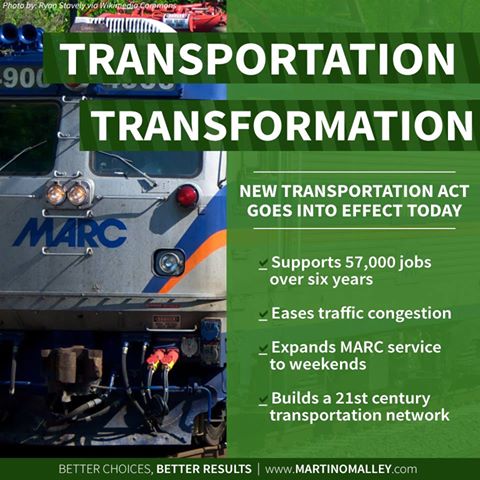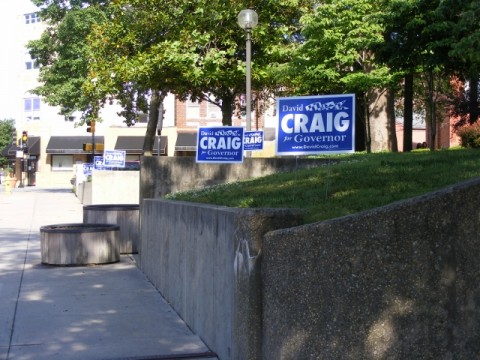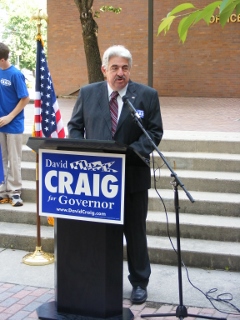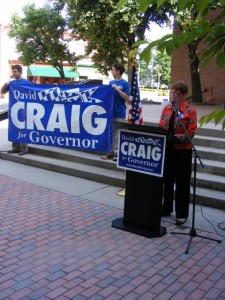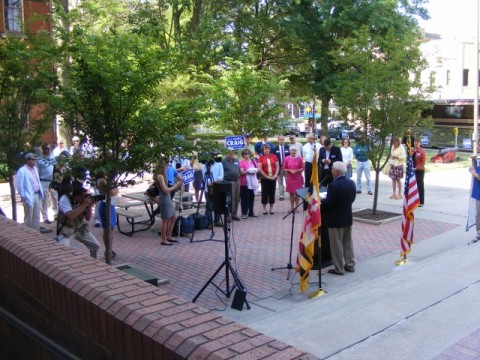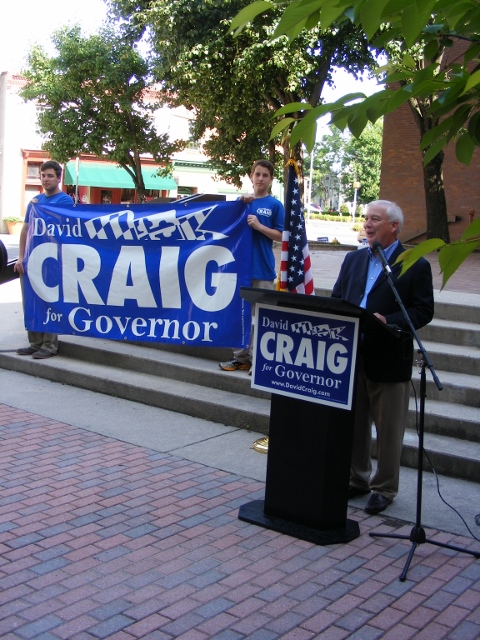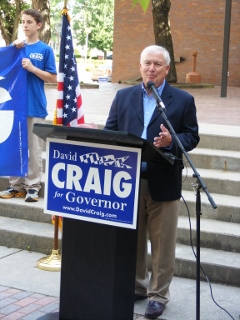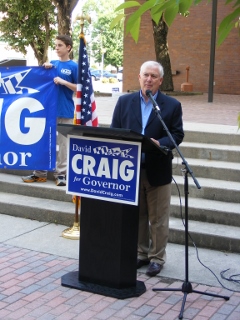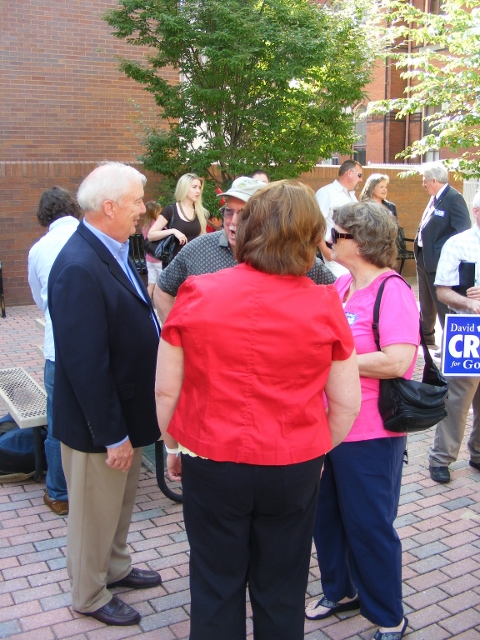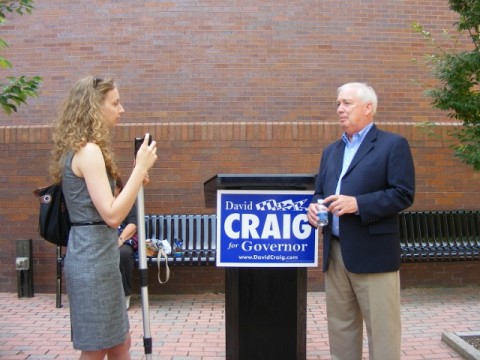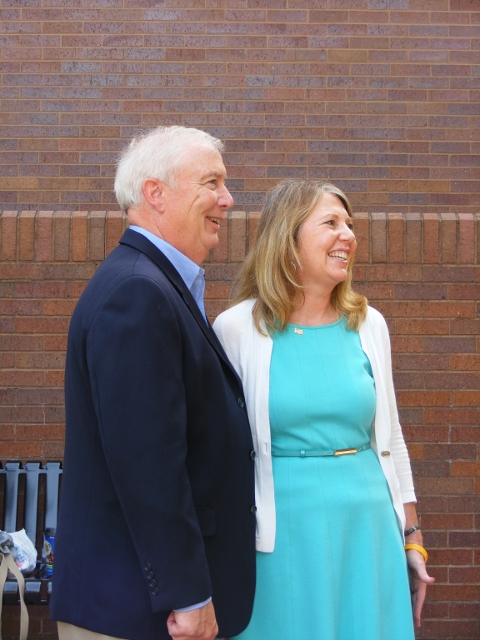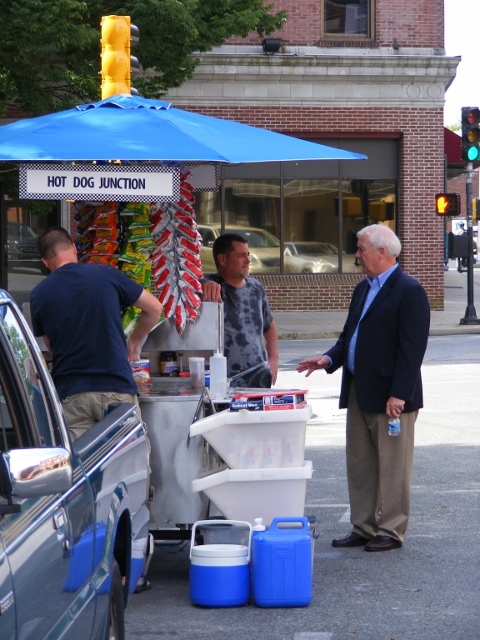Yes, I’m going to talk jobs. Some may ask why it’s only the second-most important factor and that’s because we all work to build our own wealth and maximizing control of that wealth is key. But the best way to amass wealth is through your own toil, so why not have a governor who creates the conditions to create employment?
I add the aspect of transportation into this category becaise I believe having a comprehensive and effective system of moving goods to market while allowing people the maximum freedom of movement is also important in creating employment.
And while some who dismissed this cause have already made their endorsement decision, I’m still working it out. Fourteen points are at stake here in my 100-point competition, so away we go…
**********
David Craig: Economic development will be a central focus of my Administration. As Lt. Governor, Jeannie Haddaway, and my cabinet secretaries will review every regulation harming job growth.
After we fix our tax code, our state’s economic development office will refocus on its mission of bringing jobs to Maryland – recruiting everything from warehouses, to corporate headquarters, to science labs. Our focus will be to maintain, build, and attract businesses new and old. (campaign website)
*
Reducing the individual income tax is a priority because of the importance of start-up and early stage companies that are often organized as pass-through entities. Regulations are often conflicting and duplicative among federal, state and local governments and will be the initial focus of a broader effort to overhaul the process. (Press release, October 4, 2013)
*
Asked about business, Craig intended to hold quarterly business roundtables. Because it affected local businesses in advance of consumers, we knew about the recession back in 2008, said Craig, and Harford County made budgetary decisions in a proactive fashion based on that knowledge. (WCRC meeting, July 22, 2013)
*
And Craig raised questions about whether the Red Line, a light-rail project in Baltimore, should be built. (Washington Post, May 31, 2013)
Ron George: Grow the tax base in Baltimore, allowing other jurisdictions to keep their money home for infrastructure and education needs. Remove burdensome regulations.
Bring back large corporate manufacturing companies to Baltimore to create entry level and mid-level jobs. Attract the import and export industry to make use of our newly expanded Port and BWI.
Bring back mid size and small manufacturing firms to the Eastern Shore, Western Maryland, and Southern Maryland small cities, towns and rural cross-roads where property taxes are lower and homes for workers more affordable.
Assist small cities such as Chestertown that have revenue saved toward broadband and other incentives, by giving them the rest of the cost they need on a pay-back basis, thus allowing these municipalities to attract small retail, IT and other businesses to areas that are more affordable to live in.
Create a true lock-box for the Transportation Trust Fund that no legislative body can draw from for other needs so all interested parties can have predictability.
Put all gas taxes toward state road and bridge creation and improvements. (note the aforementioned repeal of the 2013 gas increases and its required forced automatic increases.) (campaign website)
*
“Maryland needs regional plans, for business, for economic development and for education,” said George.
He said a state grant with a payback provision makes sense, because if it spurs a local economy, it increases the tax base. If private firms aren’t stepping up, “you need a grant to close that hole,” he said. The state “awards a lot of grants we never see a payback on. The money is gone.”
At the Port of Baltimore, the city has a chance to attract import-export businesses because of improvements there. A new generation of larger cargo ships will be able to call. “They could attract import-export businesses, but they’re not doing that now,” he said.
At the same time, there must be “a different approach for the Eastern Shore, for Kent County.” (Kent County News, August 22, 2013)
*
To conclude the initial portion of his remarks, Ron noted he was the Maryland Business for Responsive Government’s legislator of the year, in part for his work in capping the state’s boat excise tax, and promised that, if elected, “I will make sure (rural areas of Maryland) get their fair share.” (WCRC meeting, September 23, 2013)
Charles Lollar: Charles will promote the rebirth of construction and industry jobs through private-public investment that Maryland desperately needs – now. Charles will inspire companies to grow by creating the necessary economic and regulatory climate for companies to do so, but without hurting the state’s natural environment.
He wants to reduce the need for prisons by lowering the crime rate by creating avenues to rewarding jobs as industry and construction firms thrive and by increasing the influences of community based non-profits. (campaign website, “Platform”)
*
Fix a broken system that is blocking access to opportunities with over-regulation and excessive taxes. Review all unnecessary taxes and regulations and eliminate the Rain Tax. (campaign website, “Jobs and Economy”)
*
Lollar is opposed to the Purple Line, a $2.2 billion 16-mile rail project that even the richest Maryland residents are not prepared to pay for. It can only be built with substantial federal and state subsidies, as yet unappropriated: $900 million from Uncle Sam, $400 million from Maryland, and the rest from who knows where. The Purple Line is disliked by some residents because it would displace a popular walking and bike trail, but supported by developers because they think it would enhance the value of commercial property. Instead, Lollar favors small buses, which have high per-person pick-up rates. (Real Clear Markets, September 3, 2013)
*
“We have something to prove. From the day I get sworn in as your governor here in Maryland, that sign that says ‘Governor Martin O’Malley’ will come down. It won’t be replaced with ‘Governor Charles Lollar,’ it will be replaced with a tagline that says ‘Maryland is open for business.’” (SUTV interview, November 13, 2013)
**********
So let’s look at the other side. Anthony Brown has a business plan, but it leans heavily on “forg(ing) a stronger partnership between the public and private sectors.” Under “Tax Liability” it’s worth noting a priority is that it “enables state and local government to adequately fund our shared priorities.” So taxes aren’t going down anytime soon under a Brown administration. There’s a lot of “ensuring” in his plans, which is a weasel word meaning “mandating.”
Doug Gansler is marginally better, but the problem with his approach is that it has to be the right business in the right location, with a heavy reliance on tax incentives, creating a dependence on government and their gaming of the market. Why not provide the incentives of a great location and encouraging regulatory regime instead of picking winners?
Meanwhile, Heather Mizeur would absolutely devastate job creation in the state by raising the minimum wage, instituting mandatory paid sick leave, and putting combined reporting into effect. In terms of transportation, it’s also telling that she places “investments” in public transportation – a manner of getting from place to place with the least amount of freedom – on a higher priority than fixing roads and bridges. This is exactly backwards.
**********
So how do the Republicans rate?
In looking at what David Craig is saying, I can’t find fault with his approach. Economic development on a state level shouldn’t be about only bringing certain, politically correct businesses. And certainly a pruning of regulations is long overdue.
While there’s been some question about Harford County’sjob creation methods, they are all within the toolbox of incentives allowed by the state.
But I’m a little leery about whether David would be swayed by politics and keep the Red Line. I really wish I knew a little more about his transportation plans, but his manufacturing plan seemed to indicate he had a pretty decent idea about how Maryland could grow. I’ll grant him 9 of 14 points.
There are two broad pieces I really like about Ron George‘s plan: it scraps the whole “One Maryland” concept put in place by the current administration, and it emphasizes manufacturing in smaller towns and cities in rural areas. My hope is that Ron takes the money he locks away for the TTF and follows through on road and bridge improvements to improve truck access.
The only quibble I might have is the grant process because if there’s a payback provision, isn’t it a loan? The other problem I have is a seeming overemphasis on Baltimore City, which is vital but not all-important. Regardless, based on the confidence business has in his voting record, I give Ron 12 of 14 points.
Once again, though, I have an issue with some items Charles Lollar supports.
First of all, the aspect of public-private partnerships that Charles is expressing his interest in usually means tolls or fees collected by the private entity, which sort of blunts the appeal of the “desperately needed” investment. Ironically, the Purple Line Lollar opposes is one such PPP. The state will pay the winning private entity back over time, so where is their risk? Chances are the performance standards won’t be too difficult to attain, depending on the political payoff to the governor at the time.
The next is my wonderment at how one can cut regulations down to size, “but without hurting the state’s natural environment.” Does that mean the Chesapeake Bay Foundation has first right of refusal? Why even put in those weasel words?
Obviously I’m for eliminating the rain tax (as are all the GOP contenders) but I’m disappointed at how vague Charles is about what he would do – for example, what defines an “unnecessary” tax? I think the corporate tax is unnecessary because it makes up a small percentage of the state budget, but would you have the courage to eliminate it?
You may replace the signs at the borders to say Maryland is “open for business” – by the way, I drove into Virginia yesterday and their signs already make that proclamation – but for someone who was charged at one time with running a “Commission for Citizens Tax Relief” this seems like only lip service. Maybe my menory is faulty, but I thought Charles had gone through the budget line by line to suggest cuts once upon a time. I would expect more in-depth issue analysis.
For these and other reasons, I can only give Charles half the points – 7 of 14.
**********
The final main component is taxation, which is worth 15 points. I also have a post’s worth of intangibles, which can add or subtract up to 3 points.
At that point I can assess which candidate is my favorite – at least until Larry Hogan starts spelling out his issue positions so I can compare them.



